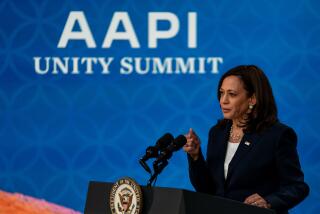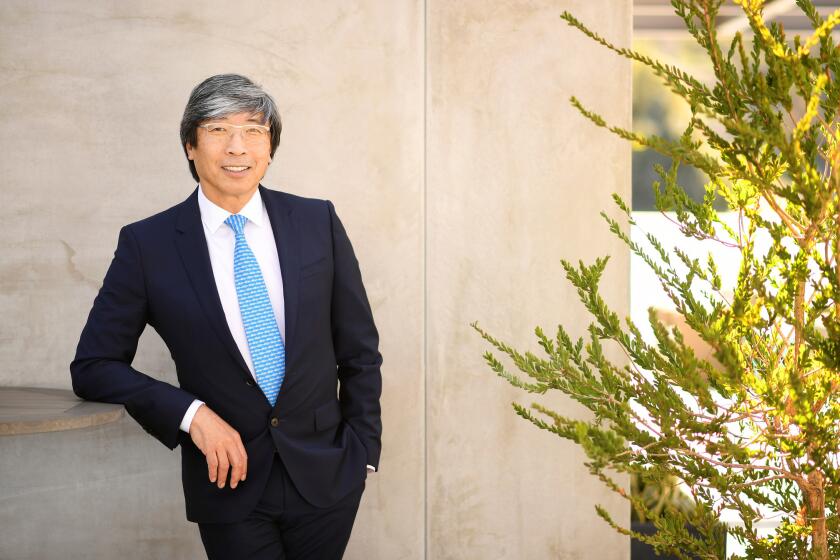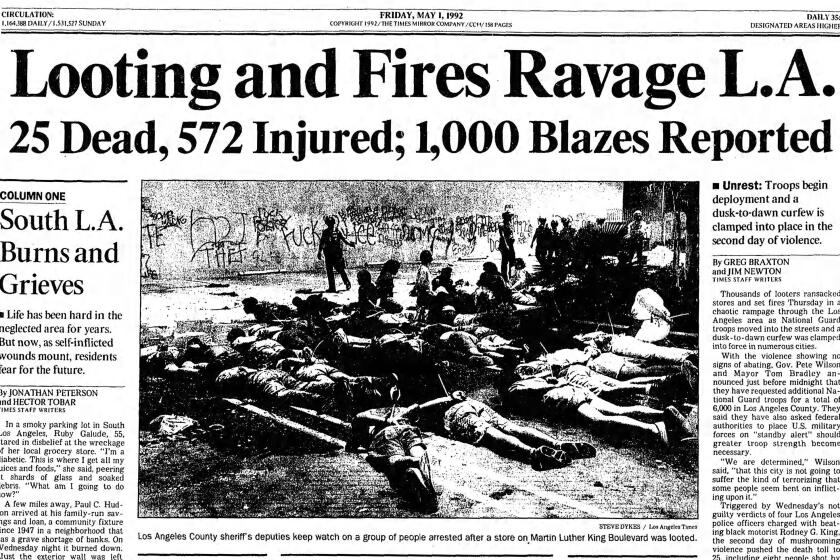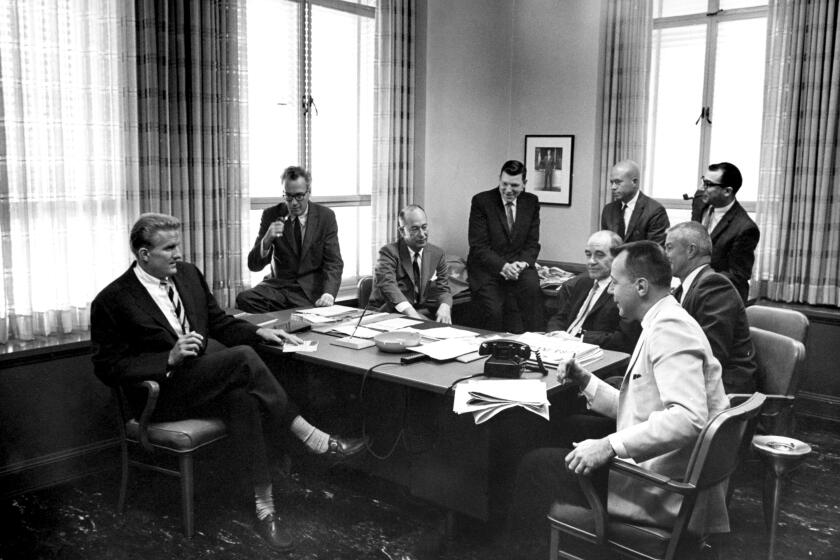How do you cover a group as diverse as Asian Americans in Southern California?
- Share via
In 1881, the Los Angeles Times ran an article titled “The Heathen Chinee,” which purported to enlighten readers about the “peculiarities of the race as observed in Chinatown.” The article appeared just four days after the paper, then known as the Los Angeles Daily Times, began publishing, and it told readers that “Chinamen” believe in goblins and ghosts and live in grimy rooms reeking of “mysterious odors.” They show “criminal carelessness” about fire safety with their open cooking braziers and — news flash! — their cheap meals of rice, mustard greens and slivers of fish and pork are the secret behind their ability to “live on a pittance” and outbid white workers for jobs.
Nearly a century later, the newspaper hired Edwin Chen, the first Asian American reporter to join the paper’s Metro staff. Chen, hired as a science writer in 1979, remembers being met by an editor on his first visit to the Metro newsroom with the greeting, “It’s Charlie Chan!” He was stunned, he says, and kept walking amid chuckles from his new colleagues.
Our reckoning with racism
As the country grapples with the role of systemic racism, The Times has committed to examining its past. This project looks at our treatment of people of color — outside and inside the newsroom — throughout our nearly 139-year history.
Today, the newspaper features smart and sensitive coverage of the community by an Asian American columnist, Asian American podcasters and other Asian American journalists, who make up 14.6% of our newsroom staff. That proportion, the largest among major U.S. newspapers, is not far from mirroring the Asian American share of the population in Los Angeles County and California.
The Times has made real headway in its coverage and newsroom representation of the nation’s fastest-growing racial/ethnic group. But it has not been nearly enough.
Of course, it’s never been easy to cover Asian Americans and Pacific Islanders. We are a dazzlingly diverse array of more than 50 ethnic groups, with different languages, cultures, religions and histories in the United States. I am a third-generation Japanese American; my paternal grandfather came from a rural village in the shadow of Mt. Fuji to settle in Seattle in 1908. My colleague Anh Do arrived here with her family in 1975 from Vietnam days before the fall of Saigon. The families of The Times’ Asian American staffers come from Japan, China, Hong Kong, Taiwan, Korea, Vietnam, India, Pakistan, Bangladesh, the Philippines.
The issue of coverage has bedeviled The Times from its inception, as the “Heathen Chinee” article demonstrates. Reading through more than a century of stories about Asian American Angelenos in the paper reveals stubbornly persistent stereotypes. No matter how long Asian American families had been in the United States — fighting its wars, paying its taxes, contributing to the nation’s well-being — they were still often seen as foreigners, exotic at best, sinister at worst.
In 1917, The Times wrote approvingly of Japanese Americans after Japan joined forces with the major Allied powers of the United States, Great Britain, France, Russia and Italy during World War I. “Thousands of young Japanese are being educated in the schools and colleges of America,” The Times wrote. “To the ancient standards of Samurai honor, to the proverbial thrift and industry of the Orient, they are adding practical, progressive American ideas.”
But after Japan bombed Pearl Harbor in December 1941, launching America’s entry into World War II, Japanese Americans were portrayed as dangerous, disloyal and unable or unwilling to assimilate. “A viper is nonetheless a viper wherever the egg is hatched,” wrote W.H. Anderson in a Times column two months later, supporting the mass incarceration of 120,000 people of Japanese descent, including my family, in 10 remote detention camps ringed by barbed wire and guarded by armed soldiers.
Although there was never any evidence of Japanese American disloyalty, The Times supported the incarceration and opposed the community’s return to the West Coast. The editorial positions followed decades of agitating for racist laws to protect white Californians from the “Yellow Peril” — and economic competition — by barring the entry of Chinese and Japanese immigrants and prohibiting them from owning land.
The newspaper apologized for its support of the incarceration three years ago, 75 years after President Franklin D. Roosevelt signed Executive Order 9066, which paved the way for the mass removal and imprisonment of Japanese Americans.
But as recently as 2016, some Times coverage still implied that Asian Americans were an unwelcome presence. In a story that year, a white music store owner who had stayed put in Monterey Park despite a “tsunami” of Asian immigrants transforming the San Gabriel Valley was likened to a xenophobic bumper sticker that read the “last American to leave Monterey Park.” The story quoted no Asian Americans. After Times staffers Cindy Chang, Rong-Gong Lin II and Frank Shyong raised objections, a top manager agreed the story did not meet Times reporting standards. But the online version of the story remained largely the same, with the word “white” inserted in brackets between “last” and “American.”)
Asian Americans are still being blamed for the acts of foreign countries. President Trump has pointedly called COVID-19 the “China virus,” and Asian Americans have reported nearly 2,600 incidents of discrimination, including verbal and physical assaults, according to Stop AAPI Hate, a national coalition of organizations. Chinese Americans are also decrying what they say is an alarming and growing racial profiling of their scientists and researchers as federal agencies crack down on China’s efforts to steal intellectual property.
Today, however, The Times is covering these stories and giving space on its opinion pages to Asian Americans writing about them.
So how does a newspaper cover the vast Asian American and Pacific Islander community today?
Newsroom representation matters. In 1981, Times journalists Bill Sing, Nancy Yoshihara and David Kishiyama became three of the founding members of the Asian American Journalists Assn., aimed in part at increasing our ranks in U.S. news organizations. The group now has more than 1,500 members in 20 chapters across the United States and in Asia.
Back then, though, our presence was so small that former Times staffer Elaine Woo still recalls her discomfort during her newsroom interview for a suburban bureau position in 1983.
“My most distinct memory was a sea of middle-aged white men in short-sleeved shirts and black ties,” says Woo, who covered the Westside before moving to education, editing and obituaries. “I thought … ‘I don’t belong here.’”
Asian Americans and other journalists of color slowly began increasing at The Times after the 1984 launch of the MetPro diversity training and hiring program. A turning point was the 1992 Los Angeles civil unrest following the acquittal of four LAPD officers caught on videotape brutally beating a Black man, Rodney King.
Stewart Kwoh, who headed a local Asian American civil rights organization, brought community leaders to meet with then-Editor Shelby Coffey III. The group was particularly concerned about how Korean Americans had been portrayed during the unrest, when the paper ran sensationalist photos of some of them on rooftops armed with guns, without adequately explaining that they took up arms because police had abandoned their neighborhoods and left hundreds of their businesses to be damaged or destroyed.
Although our two Korean-speaking reporters at the time, business reporter Don Lee and San Diego reporter John H. Lee, pitched in on coverage of the unrest with stories humanizing the Korean American community, they had their own beats to cover.
Kwoh’s group pointed out the need for someone specifically assigned to cover the Asian American community. Craig Matsuda, a longtime Times employee who left in 2008, recalls that he and other AAJA members had made a similar request to a Metro editor before the 1992 unrest but were turned down. Kwoh says that Coffey agreed on the spot to expand coverage, leading to the hiring of the late K. Connie Kang, an experienced journalist who was born in what is now North Korea, raised in Okinawa, Japan, and fluent in both Korean and Japanese.
In what came to be seen as a heyday of newsroom diversity, The Times hired many other journalists of color in the 1990s and launched a City Times section focused on the central city.
Diversity is important not only in the reporting ranks but also in decision-making roles. As an assistant managing editor, Karen Wada successfully lobbied for funds to include Asian Americans for the first time in the newspaper’s polls. In 1996, Wada became the first Asian American to join the newspaper’s masthead group of top newsroom leaders as a deputy managing editor and later as a managing editor.
After then-foreign editor Alvin Shuster sent me to Tokyo in 1991 as the newspaper’s first Asian American foreign correspondent, he was succeeded by Simon Li, who sent other Asian American correspondents to foreign postings, including Henry Chu and Ching-Ching Ni.
Ashley Dunn, a Chinese American who served as Metro editor from 2011 to 2014, saw the need for better coverage of Asian Americans and hired Do to cover the Vietnamese community and Chang to cover immigration and ethnic communities. Both were veteran journalists; Do had reported from Asia and Latin America and Chang had led an investigative series about Louisiana prisons.
The Times broke new ground when editors named Shyong as our first Asian American Metro columnist last year and launched our first Asian American-focused podcast by him and entertainment writer Jen Yamato in March. “Ethnic reporting is an intervention in the white perspective that is embedded in journalism,” Shyong says.
People need to update their understanding of what Asian Americans are.
— Karthick Ramakrishnan, UC Riverside political science professor
But we still have vast holes in our coverage. We largely neglect the huge presence here of Filipinos and of South Asians with roots in India, Pakistan, Bangladesh, Nepal, Sri Lanka, Bhutan and the Maldives (yes, we have all of these groups in California). Staffers have written about Filipino American veterans, nurses, COVID-19 victims, cultural practices and Historic Filipinotown; about Little India, South Asian troubles following the 9/11 attacks and Sikh truckers; and more recently, about Democratic vice presidential candidate Kamala Harris’ Indian heritage. But the coverage is spotty and not nearly what the communities deserve given their size and influence. Ethnic Filipinos and Indians now make up California’s largest Asian American groups after ethnic Chinese.
That wasn’t always true. In the early 20th century, Asian Americans were overwhelmingly ethnic Chinese and Japanese. Thanks to liberalization of federal immigration laws in 1965, 37% of Asian Americans today trace their roots to East Asia, 33% to Southeast Asia and 27% to South Asia, according to Karthick Ramakrishnan, a UC Riverside political science professor.
“People need to update their understanding of what Asian Americans are,” Ramakrishnan says.
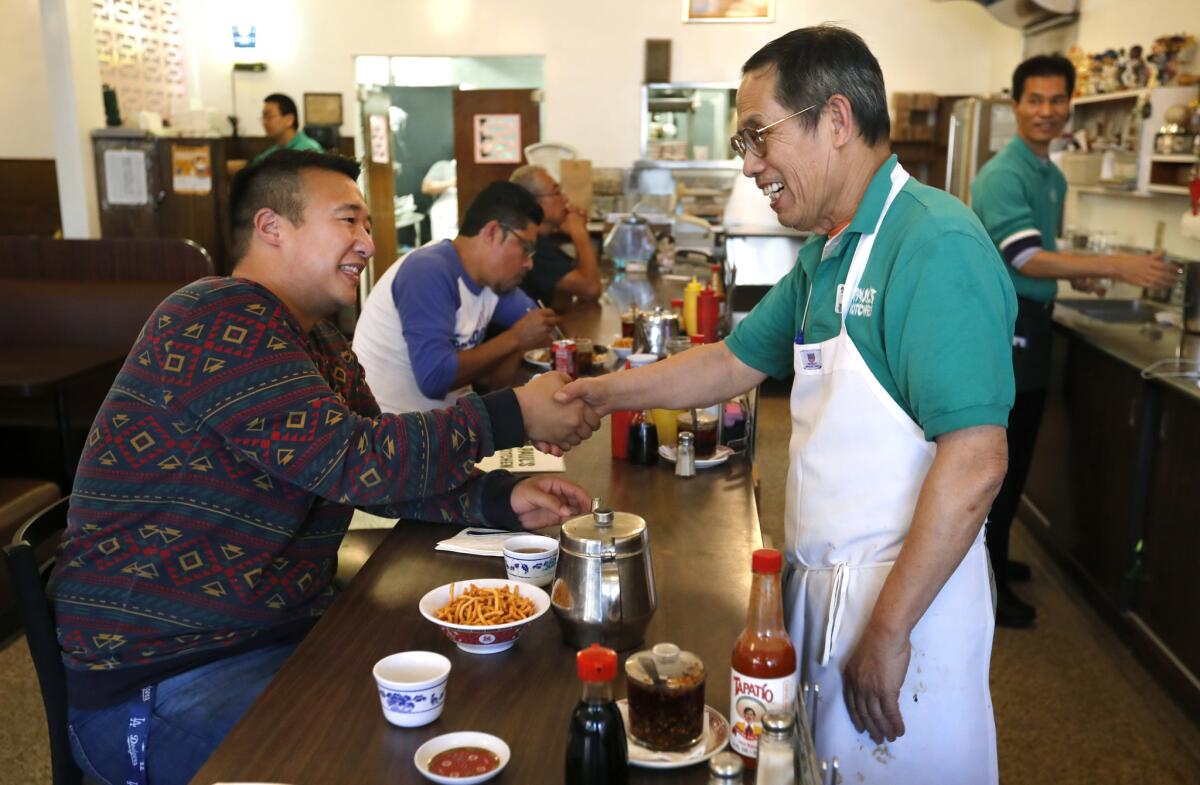
In addition, we can’t rely only on Asian Americans to cover the full breadth of Asian America. For one thing, not everyone wants that job. Chen, for instance, was born in China and speaks fluent Chinese but aspired to join our Washington bureau to pursue his passion for government and politics. He got there in 1989 and subsequently covered science, the Iraq war, presidential campaigns and the Clinton and George W. Bush administrations before leaving the paper in 2006.
Woo was drawn to education and profile writing, an art she honed with beautifully rendered obituaries.
“I didn’t want to be pigeonholed,” Woo says. “I didn’t think of myself as an Asian American or Chinese American reporter; I thought of myself as an American journalist, and I wanted others to think of me that way.”
The job is simply too vast, the communities too numerous and diverse for one or two reporters to handle alone. Shyong and Do bring expertise and excellence to our coverage, but we need to do more.
When has the paper recognized Asian Americans are not a marginal group; we’re a defining group in the area?
— Peter Hong, former Times reporter
How to do better? One idea is for reporters across the paper — Asian American or not — who know and love certain communities to keep an eye on them. While I cover higher education, I also do stories about Japanese Americans and Little Tokyo every now and then, because I know what’s happening in my community and people reach out to me with story ideas. Editors should give all reporters with a similar desire the time to break from their beats for the occasional cultural story.
More broadly, however, Asian Americans and Pacific Islanders should be part of the warp and woof, as Matsuda says, of our overall coverage. The question isn’t really how to cover Asian Americans; it is how to cover Los Angeles, because we, along with other racial and ethnic communities, are Los Angeles.
“When has the paper recognized Asian Americans are not a marginal group; we’re a defining group in the area?” asks Peter Hong, a former Times reporter who is Korean American. He calls the idea of a dedicated Asian American beat an outdated model that is “so 1980s.”
Asian American experts should be quoted in general news stories. Asian Americans should be covered as part of education, business, politics, environment, health, food, entertainment and geographical beats. Former Times reporter Mark Arax, for instance, broke new ground in the mid-1980s covering the rise of the ethnic Chinese community in the San Gabriel Valley. He is not Asian American, but he’s a terrific reporter who simply saw that demographic shift as an important part of his San Gabriel Valley beat. Later, he moved to the Central Valley and wrote about the Hmong community there along with Latino laborers, agriculture, Yosemite National Park and other local topics.
Nearly a decade earlier, William Overend wrote a piece that shattered the “model minority” myth that all Asian Americans are educated, affluent and without need for public services. In “The Chinatown Tourists Don’t See,” he wrote about poverty and isolation among Chinese immigrants, interviewing them through an interpreter.
The Times needs to invest in equipping all staff members with the cultural IQ and linguistic skills to understand our diverse communities. We live in one of the most diverse spots on the planet — both ethnically and religiously. Today, more than ever, our coverage needs to reflect that.
More to Read
A cure for the common opinion
Get thought-provoking perspectives with our weekly newsletter.
You may occasionally receive promotional content from the Los Angeles Times.



